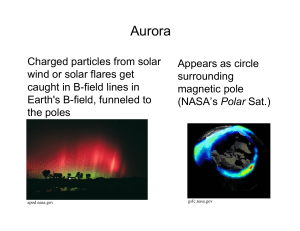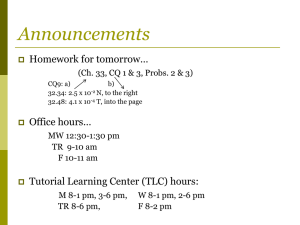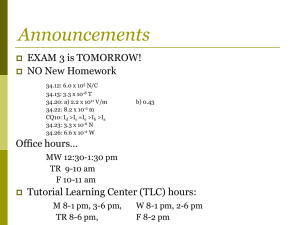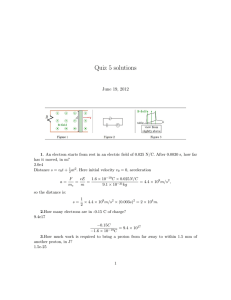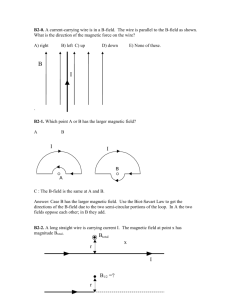19.4: Force on a Current-carrying Conductor l
advertisement
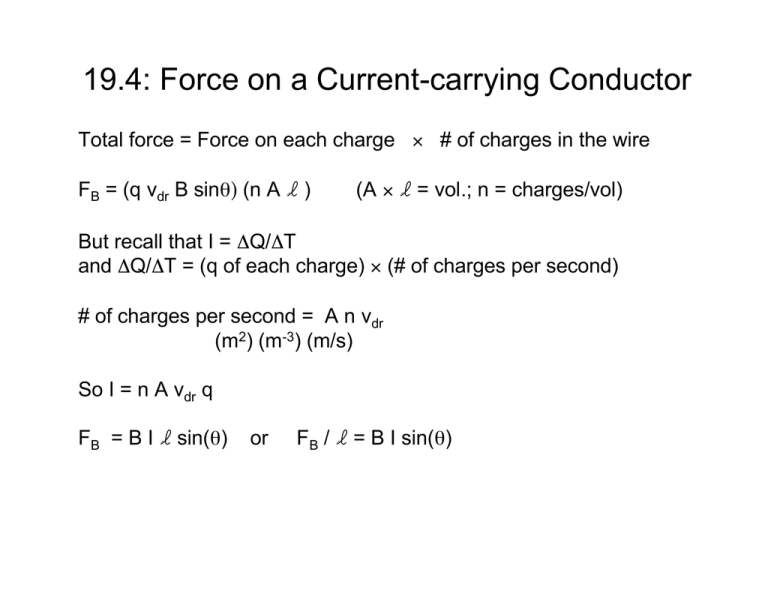
19.4: Force on a Current-carrying Conductor Total force = Force on each charge × # of charges in the wire FB = (q vdr B sinθ) (n A l ) (A × l = vol.; n = charges/vol) But recall that I = ΔQ/ΔT and ΔQ/ΔT = (q of each charge) × (# of charges per second) # of charges per second = A n vdr (m2) (m-3) (m/s) So I = n A vdr q FB = B I l sin(θ) or FB / l = B I sin(θ) Reminder: Direction of deflection is given by right hand rule: I = thumb B = fingers FB = out of your palm Example: Your magnet produces a B-field with strength 0.01 T in the plane of the page as shown. A wire carries 1 Amp from left to right, such that θ = 30º. What's the force per unit length (and its direction)? FB / l = B I sin30º = 0.01T×1A×0.5 = 0.005 N/m (out of page) So it's not much. Suppose the current is 6 Amps and the B-field is 3 T. FB / l = 9 N/m (which is slightly more substantial) B I 30º Consider a power transmission line carrying 100 Amps from W to E. What's the total force on 100m of wire due to the Earth's magnetic field (assume a North component only)? In which direction is the wire deflected (assume charge carriers are e–'s)? Reminder: the Earth's B-field is 0.5 Gauss = 0.5 × 10-4 T FB = B I l sinθ = (0.5 ×10-4 T)(100A)(100m) = 0.5 N. So, again, it's not much. Direction of deflection = downward Force on a square loop of current in a uniform B-field. Ftop = 0 (θ = 180°; sinθ = 0; so FB = 0) Fbottom = 0 Fleft = I b B (out of page) Fright = I b B (into page) Assume loop is on a frictionless axis What’s the TORQUE on the current loop? Fig. 19.15b in text is the view along the axis, from the bottom towards the top. Reminder: torque = F × r = F r sinθ τ = Fleft a/2 + Fright a/2 = (B b I + B b I) a/2 = B I A A = area; θ=90º here Note direction of torque: clockwise For 1 loop: τ = BIA sinθ τmax = BIA For N turns: Total current = NI τ = BIAN sinθ Magnetic Moment µ = IAN µ always points perp. to the plane of the loops (points along the normal) τ= µB sinθ A coil consisting of 100 turns, each carrying 3A of current and having an area 0.2 m2, is oriented such that its normal makes a angle of 45º with a B-field of 0.5T. Find the total torque on the coil. What’s the direction of rotation? • B • × A coil consisting of 100 turns, each carrying 3A of current and having an area 0.2 m2, is oriented such that its normal makes a angle of 45º with a B-field of 0.5T. Find the total torque on the coil. What’s the direction of rotation? • B • × τ = BIANsinθ = (0.5T)(3A)(100)(0.2m2)sin45º = 21.2 Nm A coil consisting of 100 turns, each carrying 3A of current and having an area 0.2 m2, is oriented such that its normal makes a angle of 45º with a B-field of 0.5T. Find the total torque on the coil. What’s the direction of rotation? • B • × τ = BIANsinθ = (0.5T)(3A)(100)(0.2m2)sin45º = 21.2 Nm What would happen if the current were flowing in the opposite direction? × • • A coil consisting of 100 turns, each carrying 3A of current and having an area 0.2 m2, is oriented such that its normal makes a angle of 45º with a B-field of 0.5T. Find the total torque on the coil. What’s the direction of rotation? • B • × τ = BIANsinθ = (0.5T)(3A)(100)(0.2m2)sin45º = 21.2 Nm What would happen if the current were flowing in the opposite direction? × • • Same magnitude of τ, but rotation is now CW B normal vector • • • • × • • • × #1: θ=90º • #2: 0º < θ <90º × × #3: θ=0º #4: 90º < θ <180º torque acts to align plane of loop perpendicular to Bfield (align normal vector with B-field), as in #3 (if released from rest in this position, it won’t rotate) B normal vector • • • × • • • × #1: θ=90º × • #2: 0º < θ <90º × • #3: θ=0º #4: 90º < θ <180º As loop is rotating, what would happen if we switched the direction of current immediately after #3? B normal vector • • • × • • • × #1: θ=90º × • #2: 0º < θ <90º × • #3: θ=0º #4: 90º < θ <180º As loop is rotating, what would happen if we switched the direction of current immediately after #3? B normal vector • • • × • • • × #1: θ=90º × • #2: 0º < θ <90º × • #3: θ=0º #4: 90º < θ <180º As loop is rotating, what would happen if we switched the direction of current immediately after #3? The loop would continue to rotate clockwise! Electric motors •If direction of current is switched every time τ is about to change sign, then τ will never change sign! •Loop will rotate nonstop: we have an electric motor (electrical energy converted to mechanical (rotational) energy)! •Fans, blenders, power drills, etc. •Use AC current (sign changes naturally), or if you only have DC current available…. How do you switch the sign of current every half cycle? Use a "commutator" Magnetic Field of a long straight wire; Ampere’s Law In 1819, Oersted (Denmark) noticed that a magnet (compass needle) was deflected when current was drawn through a nearby wire. 1820: compasses in a horizontal plane: Direction of deflection indicated “right-hand rule #2”: Magnetic Field of a long straight wire B-field lines form concentric circles: Notice that the iron filings are more strongly aligned closer to the wire Magnitude of B is the same everywhere along a given radius: |B| depends only on r (& physical constants) Magnetic Field of a long straight wire The magnitude of the field at a distance r from a wire carrying a current of I is µo = 4 π × 10-7 T.m / A µo is called the permeability of free space Ampere's Law: A more general method for deriving magnitude of B-field due to sources of current 1. Construct a closed path consisting of short segments, each of length Δl 2. B = magnetic field B|| = Component of B-field PARALLEL to Δl Consider the product B|| * Δl 3. Sum of these products over the closed path = µ0 I Take advantage of symmetry. When B-field lines are circles, we choose a circular Amperian loop. B is already || to the circle at all points on the circle Σ B||Δl = B|| * circumference = B|| * 2 π r = µ0I Rearrange to get Example: A Co-axial cable Inner conductor and outer conductor of radius Rout carrying currents in opposite directions. I What's B at r > Rout? I KEY: Remember SUPERPOSITION! +I + –I = zero total current, so B-field = 0. Example: A wire carrying 5A of current travels vertically into the page. At what distance r will the B-field equal the Earth's B-field (which points northward) at the surface, 0.5 Gauss? If 4 compasses are placed N,S,E,W of the wire at this radius, how will each compasses' needle be deflected? BEarth r × Example: A wire carrying 5A of current travels vertically into the page. At what distance r will the B-field equal the Earth's B-field (which points northward) at the surface, 0.5 Gauss? If 4 compasses are placed N,S,E,W of the wire at this radius, how will each compasses' needle be deflected? BEarth r × r = µ0I / 2πB r = (4π × 10-7 T m / A)(5A)/ (2 π 0.5×10-4T) = (2 × 10-7 T m / A)(5A) / 0.5×10-4T = 2 × 10-2 m = 2 cm. Example: A wire carrying 5A of current travels vertically into the page. At what distance r will the B-field equal the Earth's B-field (which points northward) at the surface, 0.5 Gauss? If 4 compasses are placed N,S,E,W of the wire at this radius, how will each compasses' needle be deflected? BEarth r × r = µ0I / 2πB r = (4π × 10-7 T m / A)(5A)/ (2 π 0.5×10-4T) = (2 × 10-7 T m / A)(5A) / 0.5×10-4T = 2 × 10-2 m = 2 cm. Example: A wire carrying 5A of current travels vertically into the page. At what distance r will the B-field equal the Earth's B-field (which points northward) at the surface, 0.5 Gauss? If 4 compasses are placed N,S,E,W of the wire at this radius, how will each compasses' needle be deflected? BEarth r × r = µ0I / 2πB r = (4π × 10-7 T m / A)(5A)/ (2 π 0.5×10-4T) = (2 × 10-7 T m / A)(5A) / 0.5×10-4T = 2 × 10-2 m = 2 cm. The E compass will spin freely (FB_Earth = FB_wire). The W compass will really point north, as it feels 2 * FB_Earth The N compass will point NE The S compass will point NW A power line 20m above the ground carries a current of 1000 A from E to W. Find the magnitude and direction of the B-field due to the wire at the ground below the line, and compare it to the Earth's B-field. Repeat for a wire 10m above ground. At 20m: B = µ0I / 2πr = (4π × 10-7 T m / A * 1000 A) / (2 π 20m) = 1 × 10-5 T -- about a factor of 3-5 smaller than the Earth's B field (0.3-0.5 Gauss). At 10m: B(r=10) = 2 × B(r=20) = 2 ×10-5 T -- still just smaller than the Earth's B-field Direction of B-field when you’re below the wire: south
